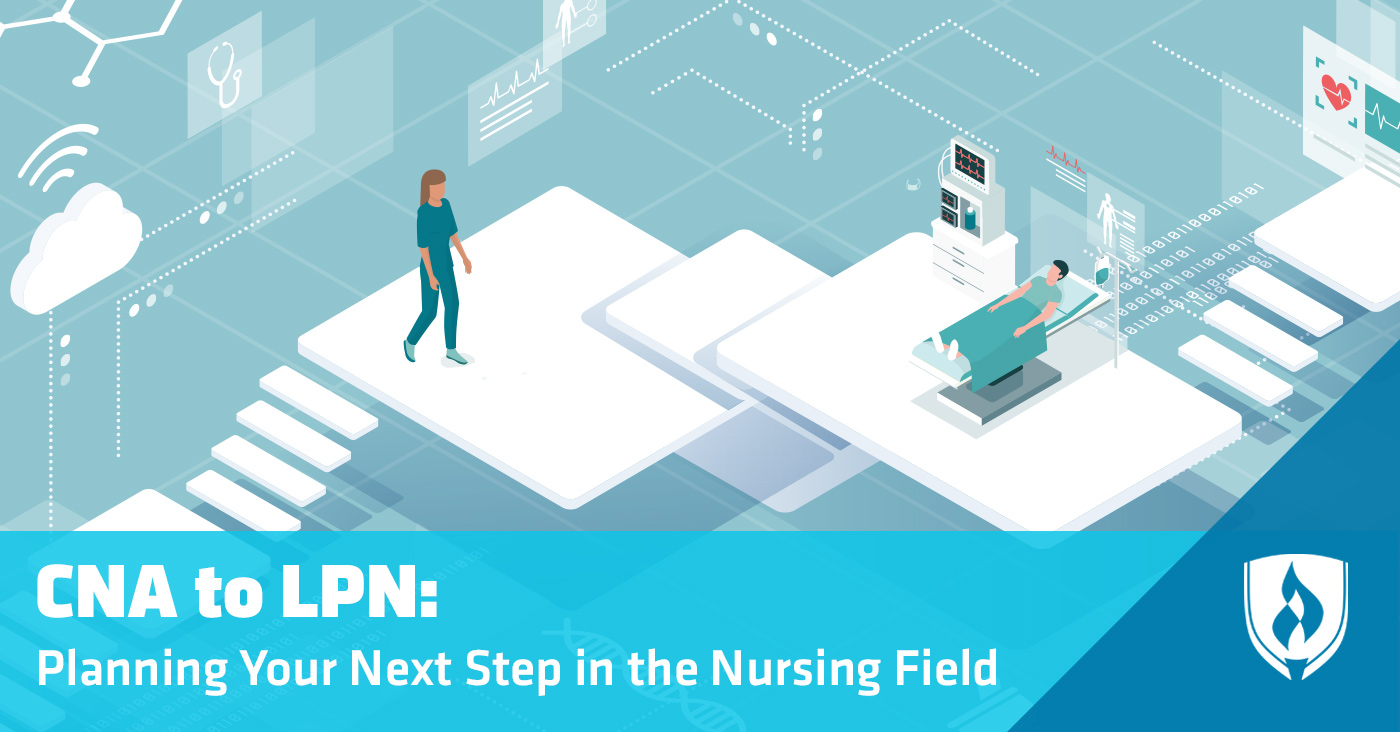For most, working as a certified nursing assistant (CNA) can be a mixed bag of good and not-so-great. Caring for people who need help can be a messy business, but when you get to know some of those people—the work becomes more fulfilling.

This is something the nursing profession has always understood. Even if other areas of our healthcare system lose sight of the patients behind the numbers, nurses are there to remember that every patient deserves help and respect.
But even though the purpose of caring for patients is the same among CNAs and licensed practical nurses (LPNs), there are some significant differences between these roles. If you’ve thought about making the step from CNA to LPN, then read on! Nursing programs and healthcare facilities make the transition easier than you might think.
Get Your Nursing School Questions Answered at a Nursing Information Session
Why make the move from CNA to LPN?
There are some definite perks to becoming an LPN.
“Although the roles of CNA and LPN both meet vital patient care needs in a high area of demand, the opportunities for LPNs are endless,” says Dr. Angela Christian DNP, RNC and dean of nursing at the Rasmussen College School of Nursing. “Beyond the obvious financial benefit of becoming an LPN, there are several other aspects to the LPN role that I believe should be considered as a benefit.”
She emphasizes the broader scope of practice that an LPN has as it allows the nurse increased autonomy and responsibility. The opportunities for LPNs include a wide array of environments that are flexible to meet almost any lifestyle, according to Dr. Christian.
The transition can be a little more natural for those who are already CNAs, as there is definitely some crossover between these roles. A CNA’s working skill set and background in healthcare sets you up well to pursue a degree as a licensed practical nurse.
Another reason CNAs might consider the change is the extra leg room LPNs get in career advancement. “The possibilities for promotions and career advancement as an LPN are numerous, whether or not you want to return for a higher degree,” Dr. Christian says, adding that LPNs sometimes find that their employers will assist them with tuition if they decide they’d like to become a registered nurse (RN) later on.
“I hear from our students that they want to advance their career in the nursing field,” Dr. Christian says. “The LPN role is an excellent option for people who want to become a nurse in a short period of time.”
CNA to LPN: What makes the job different?
Becoming a licensed practical nurse definitely affects your paycheck—but it also has impacts how you care for patients. CNAs perform job duties like bathing patients, repositioning and assisting patients in daily movement and measuring vital signs. These tasks require training and certification, but they don’t require a degree. Licensed practical nurses, on the other hand, need to spend some time in a Nursing program—most LPN programs typically take about a year to complete.**
The extra time and investment qualifies them to perform more advanced tasks such as monitoring blood pressure, changing bandages, discussing patient care concerns, reporting a patient’s status to registered nurses and doctors and updating patient records.
What steps would I take to transition from CNA to LPN?
The first step to take if you want to move from working as a CNA to an LPN is to complete an approved educational program, according to the BLS. “Make sure to explore your options—all programs are not equal,” Dr. Christian says. “Choose a program that is truly student-centered and has a vast amount of resources and support dedicated to student success.”
After graduation, prospective LPNs need to take the National Council Licensure Examination (NCLEX-PN). Degree programs for LPNs are built to prepare students to sit for this exam.
Upon passing the exam, graduates are officially licensed to work as LPNs. If your time in Nursing school gets you excited about certain therapies and areas of expertise, then you also have the option to earn certification in areas like gerontology and intravenous (IV) therapy. LPNs can then look for work in a wide variety of settings.
“Every quarter, our program is contacted by hospitals, clinics, home care agencies, transitional care units, long-term care units and other areas of healthcare looking to recruit our LPN graduates,” Dr. Christian says.
What about additional nursing education?
Prospective nurses who aim to become RNs don’t always realize that they have several options to achieve that goal. Dr. Christian has seen students struggle to achieve the entry requirements for an RN program by studying and cramming, without ever considering wading into the nursing profession with an LPN degree first.
By taking the LPN path, students complete their degree faster and can then work as nurse while returning the RN program later, if that is their goal, according to Dr. Christian. “Our graduates happily report that after the LPN program, they score higher on the TEAS and are very well prepared for the demands of the RN program.”
If you know you’d like to become an RN someday, an LPN program can be a great way to advance your career in stages. With that end goal in mind, you can ask potential LPN programs about continuing education options in case you decide to return. Some Nursing schools try to make the bridge from LPN to RN as seamless as possible, taking prior credits and work experience into account.
Making your CNA to LPN transition happen
As you can see, the path from working as a CNA to a professional nursing career isn’t complex. You already have so much knowledge and practice in nursing from working as a CNA—and that exposure to the healthcare environment also teaches you skills beyond what a classroom environment could impart.
But you might still have questions. What are LPN degree programs like? Do LPNs have to do clinical training? What exams are involved? To get more details on the LPN career track, check out our article, “How to Become an LPN: 5 Steps to Earning Your Scrubs.”
*Bureau of Labor Statistics, U.S. Department of Labor, Occupational Outlook Handbook, [information accessed October 25, 2018] www.bls.gov/ooh/.
**Time to completion is dependent on the number of transfer credits accepted and courses completed each term.




